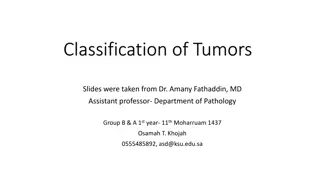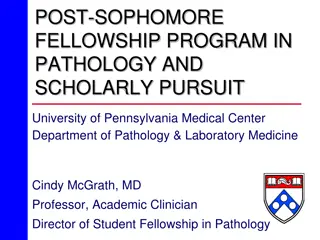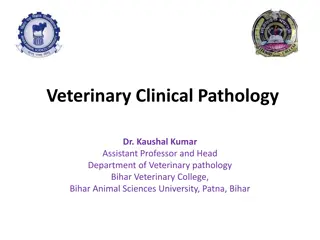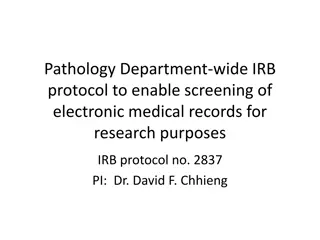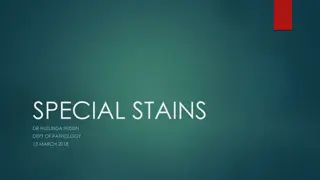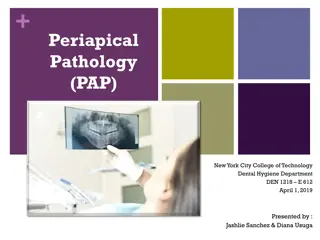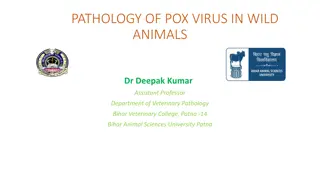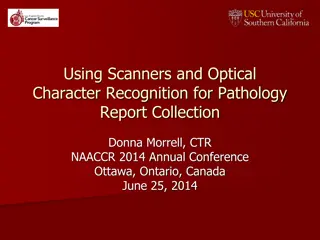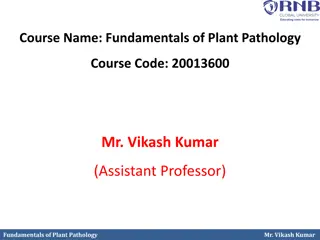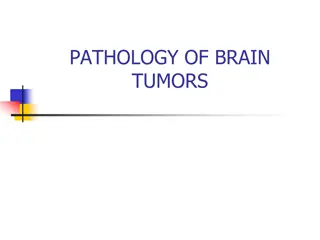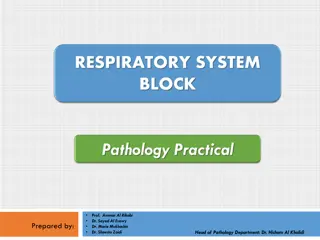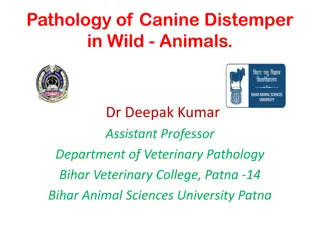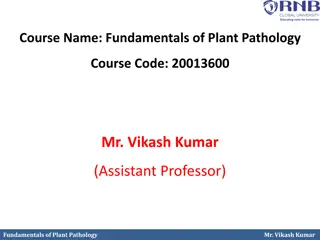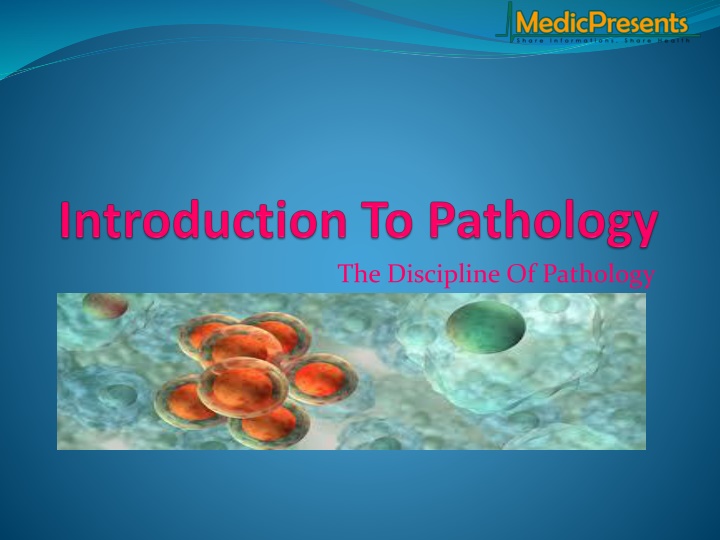
Discipline of Pathology in Medical Education
Discover the essential goals and objectives of pathology courses in medical schools, emphasizing the study of disease mechanisms and fostering lasting knowledge for students. Explore the foundational role of pathology in medical science and practice, and delve into the history and scope of this crucial discipline.
Download Presentation

Please find below an Image/Link to download the presentation.
The content on the website is provided AS IS for your information and personal use only. It may not be sold, licensed, or shared on other websites without obtaining consent from the author. If you encounter any issues during the download, it is possible that the publisher has removed the file from their server.
You are allowed to download the files provided on this website for personal or commercial use, subject to the condition that they are used lawfully. All files are the property of their respective owners.
The content on the website is provided AS IS for your information and personal use only. It may not be sold, licensed, or shared on other websites without obtaining consent from the author.
E N D
Presentation Transcript
GOAL The principal goal of the second year pathology course in medical schools is to foster understanding of the mechanisms of disease(pathogenesis) as a foundation for dealing with a vast amount of clinical information the student will encounter in later clinical years 2
The Principal Objectives To use pathology to facilitate medical education understanding mechanisms is more a function of logic than of a memory To leave students with a lasting knowledge of pathology To use pathology as the scientific basis of the art of medicine 3
What Is Pathology Pathology literally is the study (logos) of suffering (pathos) Pathology is the scientific study of disease Pathology is the foundation of medical science & practice Pathology is a bridging discipline devoted to the study of the structure & functional changes in cells, tissues & organs that underlie diseases 4
Pathology attempts to explore the whys and wherefores of the signs and symptoms of diseases Pathology much of it has a visible expressions _ Radiographs _CT-scans _MRI (magnetic resonance imaging) _Ultrasound _Clear drawings MOLECULAR abnormalities 5
History Of Pathology Era of Medical Antiquity the early dominance of animism PLATO & PYTHOGORAS Era of Morbid Anatomy Autopsies performed scientifically from about 1500A.D,19th century in Germany ROKITANSKY&ASCHOFF 6
The application of MICROSCOPY revolutionized medicine Pasteur s demonstration Rudolf Virchow (1821-1902) CELLULAR PATHOLOGY The impact of pathology in the realm of molecular changes Cancer, Congenital diseases 7
The scope of Pathology Scientific knowledge about human diseases is derived from observations on patients or , by analogy, from experimental studies on animals & cell cultures. Clinical medicine is based on a longitudinal approach to a patient s illness Clinical pathology is more concerned with a cross- sectional analysis at the level of the disease itself, studied in depth- the cause & mechanisms of the disease, & the effects of the disease upon the various organs&systems 8
Subdivisions of Pathology Histopathology: the investigation & diagnosis of disease from the examination of tissues Cytopathology:the investigation & the diagnosis of disease from the examination of isolated cells Haematology:the study of the disorders of the cellular & coagulable components of blood 9
Toxicology: the study of the effects of known or suspected poisons Forensic pathology: the application of pathology to legal purposes( e.g. investigation of death in suspicious circumstances) Chemical pathology : the study & diagnosis of disease from the chemical changes in tissues & fluids 10
Techniques Of pathology Light Microscopy- the structure of tissues & cells in health & disease Histochemistry- is the study of the chemistry of tissues Immunohistochemistry- employ antibodies( immunoglobulins with antigen specificity) to visualize substances in tissues sections or cell preparations 11
Electron Microscopy- study of disorders at an organelle level, & to the demonstration of viruses in tissue samples Biochemical techniques-fluid & electrolyte homeostasis, serum enzyme assays e.g.raised levels of cardiac enzymes in the blood Haematological techniques- in the diagnosis & study of blood disorders 12
Molecular Pathology-many advances come from the relatively new science of molecular pathology defects in the chemical structure of molecules arising from errors in the genome, using IN SITU HYBRIDISATION e.g.Hg molecule,collagen molecule, alterations in the genome governing the controlof cell & tissue growth 13
General & Systematic Pathology General Pathology: is our current understanding of the causation mechanisms ,and characteristics of the major categories of disease( e.g. congenital versus acquired diseases,inflammation,tumors,degenerations) General Pathology is the foundation of knowledge that has to be laid down 14
Systematic Pathology is our current knowledge of specific diseases as they affect individual organs or systems( e.g.appendicitis, lung cancer, atheroma). Systematic should not be confused with Systemic 15
Learning Pathology There are two apparent difficulties that face the new student of pathology: LANGUAGE&PROCESS The student must not confuse the learning of the language with the learning of the mechanisms of disease and their effects on individual organs and patients e.g. the term hyperplasia 16
Pathology is learnt through a variety of media - text book -relatively didactic lectures -tutorials -demonstrations( gross & microscopic examination of diseased tissues) -post mortem teaching -problem- solving orientated practical classes 17
Disease Mechanisms constitute general pathology A logical & orderly way of thinking about diseases& their characteristics must be cultivated -incidence -etiology -pathogenesis -pathological and clinical features - complications and sequelae -prognosis 18
PATHOGENESIS Refers to the sequence of events in the response of the cells or tissues to the etiologic agent, from the initial stimulus to the ultimate expression of the disease. The mechanism through which the etilogy( cause) operates to produce the pathological and clinical manifestations. Examples include: inflammation,degeneration , carcinogenesis,immune reactions 19
Making Diagnoses Diagnosis is the act of naming a disease in an individual patient The process of making diagnoses involves: taking a clinical history to document symptoms,examining the patient for clinical signs& if necessary, performing investigations guided by the provisional diagnosis based on signs & symptoms 20
Diagnostic Pathology In living patients we investigate & diagnose their illness by applying pathological methods to the examination of TISSUE BIOPSIES& BODY FLUIDS Biopsies are samples of tissue removed from a patient for diagnostic purposes. Resections specimens are the whole or part of an organ removed for a previously diagnosed condition. 21
Biopsies can be obtained by a variety of methods: needle biopsy, endoscopic biopsy and incisional biopsy Cytology involves the examination and interpretation of dispersed cells rather than solid tissues,usually for the diagnosis of cancer & pre- cancerous lesions. These cells can be obtained by a variety of methods according to the organ being investigated 22
Exfoliative cytology: cells shed from, or scraped or brushed off ,an epithelial surface Fluid cytology :cells withdrawn with the fluid in which they are suspended Washings: cells flushed out of an organ using an irrigating fluid Fine needle aspiration cytology: cells sucked out of a solid tissue using a thin needle attached to a syringe. 23
AUTOPSIES Autopsy( necropsy and post- mortem examination are synonymous) Autopsy means to see for oneself Autopsies are used for: -determining the cause of death -audit of the accuracy of clinical diagnosis -education of undergraduates & postgraduates 24
Research into the causes and mechanisms of disease Gathering accurate statistics about disease incidence There has been a regrettable decline in the autopsy rate during the latter half of the 20th century 25



